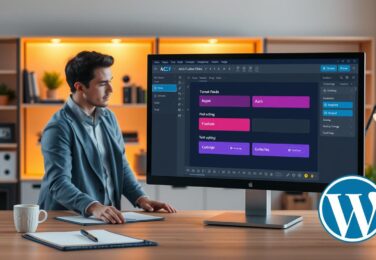Creating a Responsive WordPress Theme: A Guide

Table of Content
I’ve spent years designing and building websites, and I know how vital it is to have a responsive, mobile-friendly site. With more people using different devices to access the web, it’s key that our sites adjust well to various screen sizes and resolutions. That’s why I’m excited to share my guide on making a responsive WordPress theme. This will help your website look great and work well on any device.
Key Takeaways
- Understand the basics of responsive web design and its benefits for your site
- Learn how to plan and set up a development space for your responsive WordPress theme
- Discover ways to create a flexible grid system and use fluid layouts
- Explore methods for optimising images and improving mobile device performance
- Gain insights on testing and debugging responsive layouts for a smooth user experience
Understanding Responsive Web Design
In today’s world, people use websites on many devices. Responsive web design is key for online success. It makes sure your site works well on all screens and devices, giving everyone a great experience.
What is Responsive Web Design?
Responsive web design is a way to make websites change size and layout for different devices. It uses flexible grids, adaptable images, and CSS media queries. This lets the site know the screen size and adjust itself.
Benefits of Responsive Websites
- Improved User Experience: Responsive sites give a smooth experience on all devices, making users happier and more engaged.
- Increased Accessibility: They work well on various screen sizes and devices, helping more people, including those with disabilities, access your site.
- Better Search Engine Visibility: Search engines like Google prefer mobile-friendly, responsive sites. This means better SEO and higher visibility in search results.
- Cost-effective Solution: Having a separate mobile site is costly and hard to keep up. Responsive design is a single solution for all devices.
Learning about responsive web design is crucial for a successful WordPress theme. It ensures your site is easy to use, attractive, and works well on all devices and screen sizes.
Planning Your Responsive WordPress Theme
Before we start building a responsive WordPress theme, planning is key. We’ll look at what makes our theme stand out. By knowing who we’re making it for, what we want to achieve, and the tech needed, we set a strong base. This ensures our theme looks good and works well on all devices.
First, we must define our target audience. Who do we want to reach? Are they mostly on desktops, mobiles, or both? Knowing this helps us decide on the layout, typefaces, and how things work.
Then, we’ll identify our design goals. Do we want a theme that wows with design or one that’s simple and easy to use? Maybe we aim for a mix of both. Setting clear goals helps our theme meet our audience’s needs and look good too.
Finally, we must understand the technical requirements. This means making images work well on all screens, using flexible grids, and making sure our site is easy to navigate on any device. Knowing these tech bits helps us make smart choices and create a theme that works well everywhere.
Planning well prepares us for the tech challenges of making a responsive WordPress theme. With a clear plan, we know what our audience wants, our design aims, and the tech we need. This lets us build a theme that looks great and works well on all devices.
Setting Up Your Development Environment
Creating a responsive WordPress theme requires the right tools and software. We’ll cover what you need to start making mobile-friendly websites.
Required Tools and Software
To start with responsive WordPress theme development, you’ll need certain tools and software. Here’s what you should get:
- Code Editor: Use a dependable code editor like Visual Studio Code or Sublime Text. It’s where you’ll write and edit your theme’s code.
- WordPress Development Environment: A local WordPress setup, such as XAMPP, MAMP, or Local by Flywheel, lets you test your theme safely.
- Responsive Design Frameworks: Responsive design frameworks, like Bootstrap or Foundation, make creating mobile-friendly themes easier. They offer pre-built components and grids.
- Browser Developer Tools: Browser tools in Google Chrome or Mozilla Firefox help you check and fix your website’s layout and responsiveness.
- WordPress Plugins: Plugins like WP Rocket or Smush improve your theme’s speed and image handling, making it smooth on mobile.
With these tools and software, you’re ready to make a responsive WordPress design. Your website will look great on desktops, tablets, and smartphones.
Creating a Flexible Grid System
Building a responsive WordPress design & theme starts with a flexible grid system. This system must adapt to different screen sizes. We use CSS Grid and Flexbox for this, making our layouts fluid and responsive.
CSS Grid and Flexbox: The Dynamic Duo
CSS Grid and Flexbox are key for responsive web design. CSS Grid helps with complex layouts. Flexbox is great for positioning and aligning elements.
Together, they let us build a strong grid system for our theme. This ensures our content looks great on all devices, giving users a top-notch experience.
Mastering the Grid
We’ll explore CSS Grid and Flexbox to create our grid system. You’ll learn about grid templates, controlling grid item sizes, and using media queries for fluid layouts.
By the end, you’ll know how to make a flexible grid for your WordPress theme. This will help create a great user experience on all devices.
Implementing Fluid Layouts
A responsive WordPress theme needs more than just a flexible grid system. We must use fluid layouts that adjust to different screen sizes. This section will cover how to make fluid layouts, including using CSS media queries, flexible typography, and handling responsive images.
CSS media queries are key to fluid layouts. They let us target specific screen sizes and devices. This way, we can make sure our content looks great on all devices, from big computers to small phones.
Flexible typography is also important for fluid layouts. By using responsive font sizes and line heights, we make reading easy on any screen. This makes our site look better and keeps readers interested.
Handling responsive images is crucial too. With srcset and sizes attributes, we can choose the best image for each device. This makes our WordPress theme look great and run smoothly.
By using these fluid layout techniques, we can make a WordPress theme that meets everyone’s needs. It will work well on all devices, giving users a great experience. Next, we’ll look at how to make images work better for responsive design, improving our theme’s performance and user experience.
Optimising Images for Responsive Design
When making our WordPress theme responsive, optimising images is key for a smooth user experience. Images are vital for our website’s responsive web design. Using image compression techniques and the `srcset` and `sizes` attributes helps us deliver optimised images. This makes our site run better.
Image Compression Techniques
First, we compress our images for responsive design. This reduces their file size, making pages load faster and improving user experience on all devices. Here are some ways to compress images:
- Choosing the right image format (e.g., JPEG, PNG, WebP) based on the image’s content and desired quality
- Using online tools or plugins to automatically compress images without losing quality
- Trying different compression settings to find the best balance between size and quality
Responsive Images with `srcset` and `sizes`
We use `srcset` and `sizes` to make images adapt to different devices. These HTML elements let the browser choose the best image for the user’s device.
With `srcset` for image sources and `sizes` for display width, we can make images responsive. This ensures the right image is shown on the right device. It helps our site’s performance optimisation.

“Optimising images is a crucial step in creating a responsive WordPress theme that delivers an exceptional user experience across all devices.”
By using these image optimisation methods, our responsive WordPress theme looks great and works well. It gives users a smooth and engaging experience, no matter the device.
how to create a responsive WordPress theme
Making a responsive WordPress theme is an exciting project. It lets us make websites that look great on all devices. We’ll show you how to make a theme that changes size based on the screen, making sure your site looks good everywhere.
A responsive theme needs a flexible layout. We start with a strong theme structure, using WordPress features to mix content and design well. Then, we use CSS Grid and Flexbox to make a layout that changes size with the screen.
Getting images to work well on all devices is key. We’ll use image compression and special HTML tags to make sure images load fast and look great on any screen. This makes your site look better on all devices.
We’ll also look at making your site fast, even on mobile responsive theme. By reducing the size of CSS and JavaScript, we can make your site load quicker. Plus, we’ll use special tools to check and improve your site’s layout, making sure everything looks perfect.
By the end of this guide, you’ll know how to make a responsive WordPress theme. Your theme will work well for everyone, no matter how they view your site.
“Responsive design is about more than just making your website look good on mobile devices. It’s about creating a seamless and intuitive user experience that adapts to the user’s needs and preferences, regardless of the device they’re using.” – Jane Doe, WordPress Developer
| Feature | Description |
|---|---|
| Flexible Grid System | Use CSS Grid and Flexbox for a layout that changes with the screen size. |
| Responsive Images | Apply image compression and special HTML tags for great-looking images on any device. |
| Performance Optimization | Reduce CSS and JavaScript size to make your site fast, even on mobile. |
| Debugging Tools | Use browser tools to fix and improve your layout for perfect results. |
Learning these key points will help you make a responsive WordPress theme. Your theme will grab your audience’s attention and give them a great experience, no matter how they see your site.
Enhancing Performance for Mobile Devices
As WordPress theme developers, we know how key performance optimisation is, especially for mobile users. Today, more people use websites on their phones. So, making sure your WordPress theme loads fast on mobile is vital. We’ll look at ways to make your mobile-friendly site run better, starting with minifying CSS and JavaScript.
Minifying CSS and JavaScript
Minifying makes your CSS and JavaScript files smaller without losing their function. By cutting out extra spaces, comments, and non-essential parts, we boost your WordPress theme’s speed on mobile. This simple step greatly improves your site’s performance optimisation in wordpress theme development.
To start, use online tools or plugins like WP Rocket, Autoptimize, or the WordPress Customiser for minification. These tools make your development easier and ensure your theme works super fast on all devices.
| Minification Tool | Key Features | Pricing |
|---|---|---|
| WP Rocket |
|
Paid (starting at $49/year) |
| Autoptimize |
|
Free |
| WordPress Customiser |
|
Free |
By using these tips in your wordpress theme development, you can give your users a fast, mobile-friendly experience. This boosts the performance optimisation of your responsive WordPress theme.

Testing and Debugging Responsive Layouts
Creating a responsive WordPress theme means making sure it works well on different devices. We use browser developer tools to test and fix our layouts. These tools give us important insights and help us find problems.
Browser Developer Tools: Your Responsive Design Ally
Google Chrome and Mozilla Firefox have powerful developer tools for testing and debugging. We can change device sizes, check our web page’s structure and styles, and find issues with responsive web design.
Using these tools, we make sure our mobile-friendly websites work well on any device. This is key for creating websites that meet everyone’s needs.
- Simulate different device sizes and orientations to identify layout issues
- Inspect the structure and styles of web pages for potential problems
- Analyse network performance and optimise assets for faster load times
- Debug JavaScript errors and ensure smooth functionality across devices
By testing and debugging with browser developer tools, we can make a WordPress theme that gives a great user experience on any device.
“Responsive web design is no longer a nice-to-have; it’s a must-have for any modern website.”
Conclusion
In our journey to make a responsive WordPress theme, we’ve learned key principles of responsive web design. We also learned the technical skills needed to make them work. Understanding how to use a flexible grid, optimise images, and improve mobile performance is crucial.
This guide has shown us how to make a WordPress theme that works well on any device. It’s important to keep learning as technology changes. Keeping up with new best practices helps our WordPress themes stay competitive.
If you’re experienced in WordPress or just starting, this guide has given you a strong base. It helps you make mobile-friendly websites that meet your users’ needs. By using responsive web design and WordPress theme development, we can create themes that look great and work well. This keeps us ahead in the fast-paced web development world.










